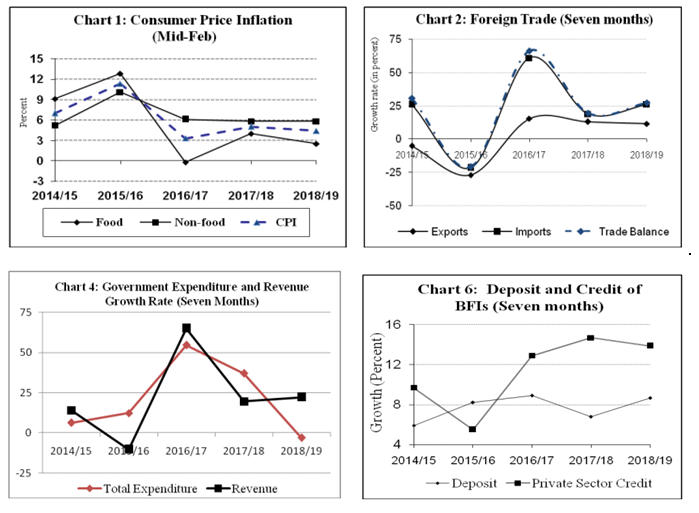Increasing imports, decreasing exports, increasing remittance, decreasing FDIs: Have the macroeconomics indicators changed their status in the seven months?
Sun, Mar 17, 2019 9:28 AM on Economy, Exclusive, Stock Market,
The central bank of the country published its macro-economic update based on seven month’s data of 2018/19. The report covers major details on inflation, trade, services, remittance, BOP position, foreign exchange reserves, fiscal deficit, surplus, expenditure, revenue, money supply, deposit, credit liquidity, interest rates and capital market.
Some of the major highlights from the reports are:
Inflation: Inflation remained at 4.4% in the review month compared to 5% of the same period last year.
Import and export: Imports of the nation expanded 26% amounting to Rs 833.27 billion, which had expanded by 18.9% last year. On the other hand, the export has risen only by only 11.5% amounting to Rs 53.08 billion. This figure was 12.9% last year.
Services: Net service deficit increased to Rs 10.78 billion compared to that of Rs 2.96 billion in the same period, last year. For the seven months of this year, travel payments worth Rs 54.96 billion has gone out of Nepal, out of which Rs 28.66 billion is for education.
This shows an increasing trend of brain-drain and skilled Human capital outflow.
Remittance: Remittance increased 28.5% amounting to Rs 515.55 billion. Remittance had increased by 1.7% in the same period of the previous year.
Current account: It posted a deficit of Rs.166.24 billion in the review period against the deficit of Rs. 142.09 billion in the same period of the previous year.
BOP position: The overall BOP remained at a deficit of Rs. 49.32 billion in the review period compared to a deficit of Rs. 18.28 billion in the same period of the previous year.
FDI inflows: Nepal received FDI worth of Rs 5.15 billion which was Rs.14.34 billion last year in the same period.
The declining FDI inflow might be the result of our political leaders’ coziness with communist economies, which indirectly assaults our relationship with democratic countries like US.
Exchange rate: Nepalese currency vis-à-vis US dollar depreciated 3.7% against 0.1% appreciation of last year in between mid-February and mid-July.
Fiscal deficit/surplus: Government of Nepal (GoN) recorded a fiscal surplus of Rs. 57.74 billion in seven months of 2018/19, which was a deficit of Rs 26.47 billion in the corresponding period previous year.
Government expenditure: The government expenditure stood at Rs 415.51 billion in the seven months of 2018/19, which was Rs 428.88 billion in the corresponding period of last year. Since all transactions are done via bank, these figures are based on the banking transactions.
Government revenue: It increased 22.1 percent to Rs. 465.74 billion which had increased 19.5 percent to Rs.381.34 billion in the corresponding period previous year.
Banking:
-Deposit collection: Deposits at BFIs increased 8.7 percent in the review period compared to a growth of 6.8 percent in the corresponding period previous year.
-Credit distribution: Credit to the private sector from BFIs increased 14.0 percent in the review period compared to a growth of 13.5 percent in the corresponding period of the previous year.
-Liquidity management: In the review period, NRB mopped up Rs.100.35 billion liquidity through open market operations. Rs.130.25 billion liquidity was mopped up in the corresponding period of previous year.
-Interbank transactions: The inter-bank transactions among commercial banks stood at Rs.860.76 billion and among other financial institutions (excluding transactions among commercial banks) amounted to Rs.165.56 billion.
-Interest rates: The weighted average 91-day Treasury bills rate decreased to 3.44 percent from 3.93 percent a year ago. The weighted average inter-bank transaction rate among commercial banks, which was 4.31 percent a year ago, increased to 5.82 percent in the review month.



